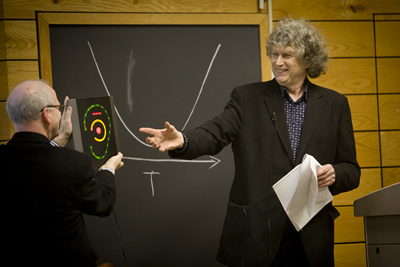Trevor Pinch expounds on the sounds of commerce
By Elisabeth Rosen

When we think of buying and selling, we usually think in terms of what we can see: money, material goods, electronic trading screens. "Sound is very much an afterthought," Trevor Pinch said Feb. 15 in the Society for the Humanities Annual Invitational Lecture.
But for Pinch, professor of science and technology studies and of sociology and author of the new book "The Oxford Handbook of Sound Studies" (Oxford Unviersity Press, 2012), sound is anything but an afterthought. His interdisciplinary research -- ranging from how street sellers use sound to extract money from a crowd to the role that sound plays in contemporary e-commerce -- makes the case that sound has always been a crucial element of economic exchange.
In his lecture Pinch focused on street sellers, or "pitchers," in North London and street entertainers on Venice Beach, Calif. Familiar to us from infomercials and state fairs, pitching is a sales technique that combines enthusiastic speech with entertaining antics to attract customers. According to Pinch, pitching is "probably the oldest form of selling" and can be traced back to hawkers at medieval markets.
To analyze the pitcher's use of sound, Pinch drew inspiration from sociologist Erving Goffman, who claimed that all social interactions can be described using the metaphor of a performance. Goffman coined the terms "front stage" and "backstage" to distinguish between the types of social performances that we participate in daily. When the pitcher uses sound, Pinch said, it is with a specific goal in mind: "People are backstage, and the pitcher is trying to move them to front stage."
To accomplish this, the pitcher has at his fingertips several colorfully named techniques. These include "pulling the edge" (getting the crowd to stop and listen), "ramping" (making a cheap item seem to be worth more), "the bat" (lowering the price in increments so that it seems like a bargain) and "twirling the edge," which enables the pitcher to maximize his sales by "spinning out each sale like a twirling top, trying to draw more and more people (known as 'the edge') into the sale." Often, Pinch said, the pitcher will ask for a show of hands of who is interested and use this to make people feel obligated to buy the goods, a technique called "getting the forks up." And sometimes he will even distribute the goods before announcing the final price: "the nailer." Street entertainers also seek to put the audience under an obligation for having stopped to watch and listen.
It is sound, Pinch said, that gives the pitcher his "trump card." Sound plays a role in all of these rhetorical devices; moreover, the pitcher's voice is amplified, while individual audience members are virtually powerless to make themselves heard.
"In a crowd it's hard to tell where the sounds come from," Pinch said. "We've often seen this happen: A pitcher will appear to be soliciting information from the back of the audience, when in fact there is no audience member there."
Pinch noted that pitchers are disappearing from the streets as e-commerce and TV-shopping expand into more households.
Pinch also touched on the crucial role that sound plays in other contexts of economic exchange, such as the stock market, bond trading and the shopping mall.
"Once one gets sensitized to sound as a topic, one starts to notice it everywhere and to ponder its neglect," Pinch said.
Elisabeth Rosen '12 is a writer intern for the Cornell Chronicle.
Get Cornell news delivered right to your inbox.
Subscribe